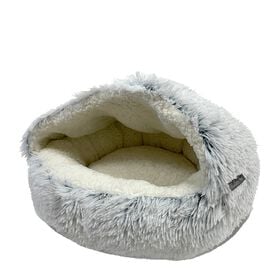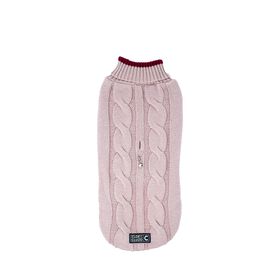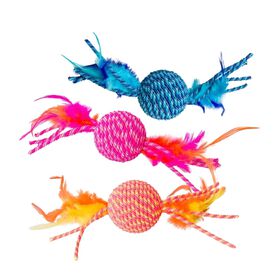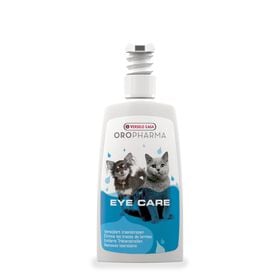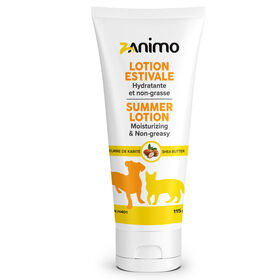Whether you find it pretty or not, this naked cat rarely leaves people indifferent.
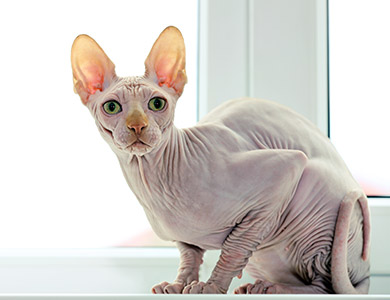
Origins of the Sphynx
Though some hairless cats were born in other parts of the world, the Sphynx originated in Canada! The very first naked cat to be recorded was born in Toronto, Ontario, in 1996. This little kitten named “Prune” would lead to discovering the genetic mutation responsible for the absence of fur. Attempts were made to reproduce other hairless cats like Prune, but the gene was recessive: Some cats had fur, others did not.
It took about 30 years of crossbreeding of Devon Rex cats—itself a shorthair breed—with different hairless cat breeds in other parts of the world as well as with domestic cats to obtain the definitive breed, meaning a healthy breed with an acceptable genetic stock. As the work was primarily done in Europe—in France, to be exact—the Sphynx is often considered to be of French origin.
Appearance and morphology
The Sphynx is distinguished primarily by its lack of fur, or rather, it’s quasi-absent coat. What’s key for this breed is to appear to have no fur. The majority of Sphynxes have a thin, barely visible layer of fuzz on their body. Others have a few strands on their neck, eyes, at the bottom of their tails, or on their digits. Whiskers are rarely or never seen, and when they are, they are often broken. Rubbing a Sphynx is like touching a plush toy or chamois leather. Their skin will appear much more wrinkled during the kitten stage than during the adult stage.
The other defining characteristic of Sphynxes is without a doubt the size of their ears and the large streak on the top of their heads, which is neither too high nor too low. They have a medium-size build and their bone structure and musculature are well-developed. They have a large chest which gives them somewhat of a bulldog-like appearance, while their tails often draw comparisons to that of a rat: long, thin, and hairless! Their stomachs, while firm and not plump, do protrude slightly, making them appear as if they’ve just eaten a hearty meal!
And lastly: their big, bright eyes, which look like perfectly rounded lemons, combine with the folds on their foreheads and their enormous ears to give an inquisitive air to their uniquely alluring look.
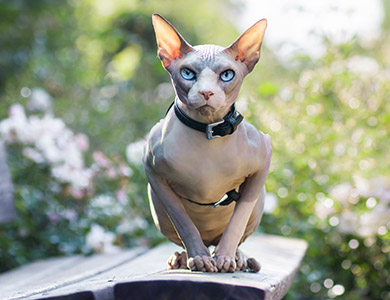
Sphynxes require a lot of care
You might think a hairless cat doesn’t require much maintenance, but this is not at all the case. To the contrary, Sphynxes are one of the most high-maintenance breeds! You should, therefore, be prepared to invest some time when adopting a Sphynx
Sphynxes produce sebum on their skin and sometimes secrete too much of it, which ends up clogging their pores or making them slightly oily. However, contrary to popular belief, you should not systematically wash a sphynx to remove this sebum, as it also protects the skin. It's important to consult your vet about how to care for your cat, as each sphynx requires different care depending on the amount of sebum it secretes.
Also, carefully clean their ears, the area around their nails and even their skin folds. Some cats may even require daily hydrating lotion.
If you have a sphynx cat, it is important to take extra care when exposing them to sunlight. Due to their lack of hair, sphynxes are very sensitive to sunburn and it is advisable to apply sun cream to protect their skin. Additionally, sphynxes have different energy requirements compared to hairy cats. They need to produce more heat to maintain their body temperature, so you should adjust their diet accordingly. However, it is important to avoid overfeeding your cat as they still require a balanced diet. Just because they need to eat more doesn't mean they should eat a lot!
Ideal family for a Sphynx
The personality of Sphynxes may vary, but in general, they are very playful, energetic, curious and take very well to humans. As you’re such great heat sources, you’ll often find your Sphynx at the foot of the bed or beneath the covers, snuggled up against their favourite human. Their clinginess is what earned them the nickname “Velcro cat!”
Sphynxes need their family to be fairly present in the home. The ideal owner is a single person or a couple with no kids who has time to devote to their cat. Nonetheless, if you are confident you can provide a stimulating and suitable environment, and you want a cat whose personality will be a good fit for your family, adopting a Sphynx can be a wise choice regardless of your situation.
Lastly, in no way does their lack of whiskers impede Sphynx’ physical abilities. Furthermore, since these cats lose heat quickly, they are often used as heating pads, not unlike hairless Mexican dogs are. And remember: they’re known as the Velcro cat—so everyone wins!
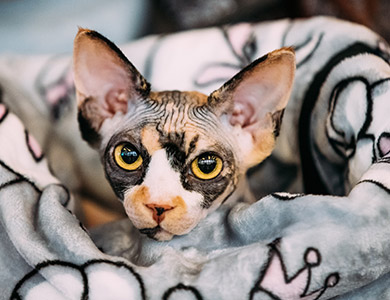
Allergies
Contrary to popular belief, Sphynxes are not hypoallergenic. It’s not their fur that causes allergies, but their salivary and sebaceous secretions. A highly allergic person may have a stronger reaction to your Sphynx than to any other cat.
The only way to reduce these risks is to properly maintain your cat so that they don’t produce a lot of flakes.
Lastly, in no way does their lack of whiskers impede Sphynx’s physical abilities. Furthermore, since these cats lose heat quickly, they are often used as heating pads, not unlike hairless Mexican dogs are. And remember: they’re known as the Velcro cat—so everyone wins!


